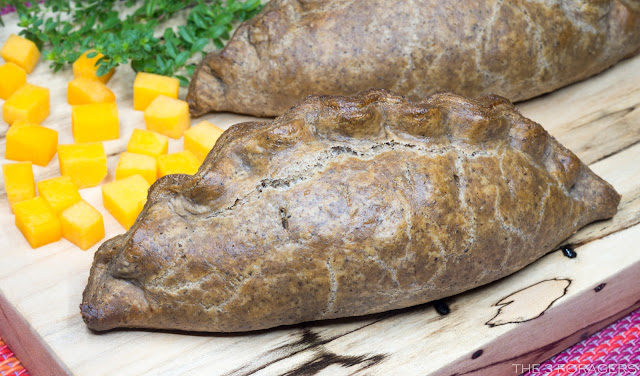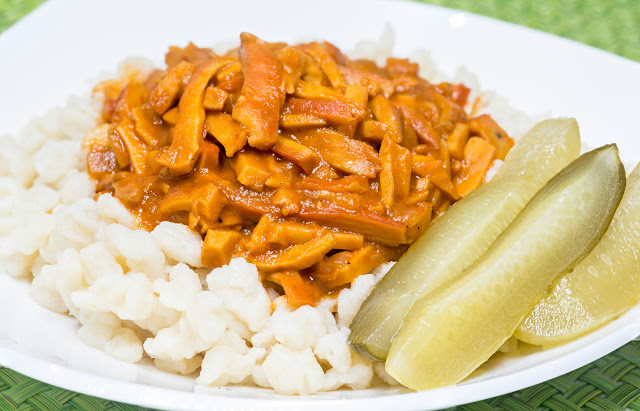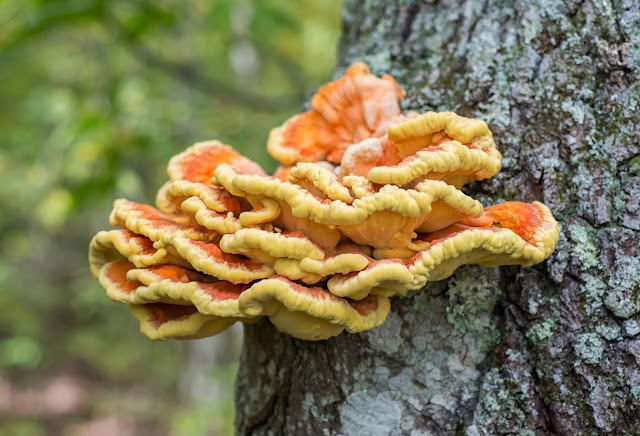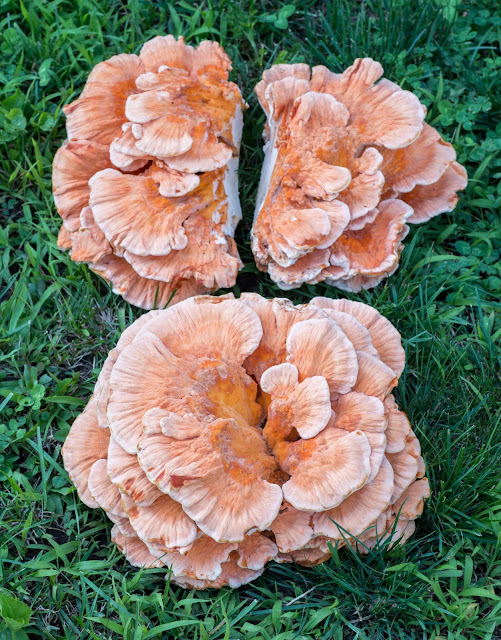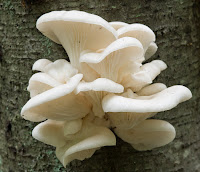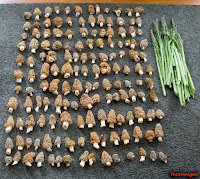 |
| Miso-Soy Glazed Maitake over Forbidden Rice Pilaf |
Wild mushrooms can be an excellent meat substitute in many meals for meat eaters and vegetarian alike for a few reasons. Their ability to satisfy hunger due to their protein content and fiber levels (beta glucans and chitins) can often "trick" even the pickiest eaters into feeling full after a meal. Mushrooms, especially wild mushrooms, have a high level of
umami--which is described as the fifth taste that humans can detect along with salty, sweet, bitter, and sour; umami is often described as a "meaty, roasty, or brothy" flavor. Mushrooms get their umami from a complex mix of glutamic acid, purine bases, nucleotides, and the breakdown of fatty acids and monoterpenes. Cooked correctly, mushrooms will have excellent and satisfying flavors for many people, and their textures can be enhanced far beyond the pale, slimy soups and canned sliced mushrooms of our childhood!
 |
| Mushroom Basket |
 |
| Bad mushroom! |
The best way to start is at the beginning: pick your mushrooms in a smart manner! Whether you prefer to pull or cut, field clean your correctly identified edible fungi before placing them in their basket. Remove the dirty bottoms, remove any visible bugs or critters, brush away any dirt or debris. If you have small wax bags or small paper sacks, they can be useful to keep your finds organized by species, and then easy to transfer to the refrigerator later. DON'T use plastic, your fungi need to breathe and will degrade quickly if kept in plastic bags. Respect your fungi--don't collect old, maggoty, slimy, or rotten mushrooms! Remember that it was free food to begin with, there is no reason to collect less than pristine mushrooms for your plate. It amazes me how many people see holes in their wild mushrooms and they shrug it off and rationalize it thinking it's worms and "extra protein", when the reality is that the holes are formed by maggots of fungus flies that eat the mushroom flesh as they burrow, pooping the whole time. Do you
really want to eat that?
Now that you have a bunch of beautifully clean, correctly identified, safe edible mushrooms, what are the best ways to cook them? (Keep in mind that how to cook and taste is strictly objective and everyone has strong opinions about how it
should be done, and these are our opinions based on our experiences.)
 |
| Golden Chanterelles, ready to tear and cook |
Prep your mushrooms: If your mushrooms are still a bit dirty, try to brush them clean with a pastry brush or a paper towel. If they are a firm mushroom, you can dunk them briefly in water and give them a spin in the salad spinner, or spray them with the spray attachment on your sink. Contrary to popular belief, they don't actually absorb that much water with a brief wash. We DO NOT ever recommend extended soaking in salty water--if your mushrooms contain so many bugs and sand that you think they need a salt water soak, they aren't worth eating in our opinion. For firm mushrooms like Boletes, chickens, morels, dryad's saddle, and white button mushrooms, we prefer to chop them with a knife. For mushrooms that are more tender like chanterelles, oysters, black trumpets, and hens, we prefer to tear them into pieces, but they can also be chopped if you prefer.
 |
| Coprinus comatus, cooked over the campfire |

To test a mushroom for flavor for the first time, we recommend a simple saute in a neutral oil (we like sunflower or grape seed oil) over medium heat. Using butter or olive oil is not recommended--butter contains milk solids that can burn, and olive oil has a low smoke point and too much of it's own flavor that overpower the mushrooms. Remember, we need to cook the mushroom enough to break down the chitins to make it digestible, and we want some flavor from caramelization. Mushrooms contain a large amount of water, so they will give off a bit of juice in the pan, allow it to evaporate. Add as little oil as possible to prevent the mushrooms from sticking, and don't over-crowd the pan. Stir to prevent sticking, but allow the mushrooms to get browned. At the end of cooking, after about 10-15 minutes, add a touch of salt.
 |
| Thai Coconut Chicken Mushroom Soup |
When using wild mushrooms in recipes, you don't need very specific, specialized recipes for each individual species of wild mushroom! Think more about the textures or flavor of a wild mushroom, and swap it out in an already known recipe to begin with, then once you have become comfortable with wild mushrooms, you will soon be creating your own recipes. When we first started cooking with the chicken mushroom (Laetiporus sulphureus), we agreed that it was their texture that mimicked chicken more than their flavor, but we still used it in similar ways to regular chicken in recipes. Now we are more likely to use chicken mushroom for its own attributes rather than a straight substitute for meat. Consider the tenderness of oyster mushrooms when thinking of recipes, consider the crunch of Lactifluus when you think of recipes, consider the texture of Hericium when it's time for dinner. You can turn the wonderful diversity of wild mushrooms with their colors, textures, and flavors into an array of dishes that the basic white button mushroom could never accomplish!
 |
| Spice Rubbed, Oven Roasted Oyster Musrooms |
 |
| Black Velvet Bolete Palmiers |
 |
| Winecap Musroom Risotto Filled Grilled Ramps Leaves |
 |
| Hen and Kasha Loaf with Hen Gravy |












